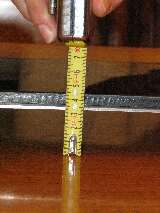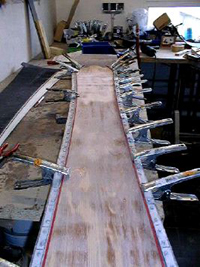MY
BOARDS
as you can see I’m definitely a hardbooter.
Also if there is "soft" snow I use
to ride an alpine snowboard, (Burton Alp 163),
I like it very much, I have a lot of fun. This
choice is -mainly- due to the usual snow conditions:
in my area snow is hard, windy. There aren't
so frequent precipitations. There are thick
woods and not so much "open" space
to ride widely.
First I had a Burton Alp 163,
than I bought a Virus Black Death2. The change
was successful and I would never come back to
first board. Nowadays I bought 2 skwals. You'll
find the characteristic below. I have to say
that is only by having a group of good friends
that meet frequently that l learned a good technique
and also the suggestions for good equipment.
I'll give my experience. First, I will explain
what was my choice and why. Virus Black Death
is 173cm long, 157cm blade length, 15,1 cm large.
"Speed machine for super fast precision
turns at high ; they wrote on the
site. After a 4-5 years of satisfactory snowboard
i felt i need more speed in the action: my board
was too large and had a lot of torsion. I need
something quicker. I decided for a 16-15 cm
large board ( so that i could decrease "blade-changing"
time) with medium rigidity but very fast in
regaining the normal position. In my case, that
is allowed by a "bridge" of 3cm. I
have to say that my board never lost this feature
after 5 years. See pic. Nowaday i canaged
and moved to a more ecleptic concept: each snow
has its own board, so i'm using all, from Ec
to skwal to race boards. 
How to choose a Board + How's made a
snowboard: . Now I’ll comment an article
I found on Virus site that explaines on the
argument.
As u can imagine boards should
be manufactured from high-tech materials in
connection with proven materials like full-wood
cores. Handcrafting costs are high, but the
result is much better than a serial one, since
the technology is not so developed. (Due to
the small market). Than best producer, should
reinforce wood core by layers of carbon fiber.
Virus says "These carbon layers are tailored
from pure and continuously woven carbon fiber.
Knowingly, we relay on only the highest quality
materials and abstain from expensive PR-campaigns
in favor of optimum riding pleasure. 
Look at the stainless steel inserts that should
be locked in titian plates, which significantly
increases the amount of force needed to rip
out a binding. "Thus the problem of bump
development in the boards’ binding areas is
eliminated." The wood cores should be pre-glued
to the final amount of camber... And it lasts
and lasts. I had a bed experience on that, I
destroyed a board and finally had to re-inserting
it. It has happened the same to Alessandro,
a friend, with the same board. Please consider
to use only screws of a certain correct length
and glue them, once u decide the correct position
of the binding. When u buy a snowboard ask the
salesman to explain this simply things about
bindings.
Nowadays boards are manufactured by using sandwich
technology: this is a costly type of production,
consider this when buying a board. Check the
thick of running bases that guarantee the precision
and performance. Also the steel edges are important,
high quality means allow you for repeated subsequent
machining enhancing the lifespan of the board.
But's hard to verify the quality of the steel,
especially now that the prices of raw material
are increasing. 
Note for beginners or middle level snowboarders:
Once you develop your own style you can think
about looking for a hand maker that will manufacture
the board you prefer. Please don't do the contrary
just to have a personalized board... you will
need the double of time to learn snowb. since
you'll have to adapt to board. Firm makers do
good standardized boards developed by lots of
experts, let use their experience. NOTE about
handmade boards: I'm speaking of not so much
expensive boards, Tomahawk that manufactures
World Cup Snowboards hand makes personalized
board for at least 700 euros. (That is less
than the average price for a Virus of F2 or
Kessler etcetc) ask Micheleali@libero.it that
is Tomahawk-addict ..
Before buying have a try with the board. It
is hard that a shop gives you such an opportunity,
but that's the only way to understand. Me and
friends, we usually do try of "strange"
(for the moment) boards. Look at the photos
of the 196cm long Tomahawk or just think at
the skwals (10-11 cm width). Ask the salesman
for that, sometimes they accept. And more, contact
me if you have any idea to try a particular
board, we'll try to arrange a contest day.
Now I use to skwal. What does it means "skwal"??
It is always the same sport, snowboarding with
2 foots in line. The difference is that the
board is not so wide; it seems a ski more than
a snowboard. It's incredible but after 8 years
snowboarding I discovered a new world. Skwal
gives the stability at high speed that a snowb
can't give. But, please, if you are intrested,
do the things in order, don't jump from a soft
board to a skwal because it wouldn't have much
sense, you'd hate it.
So finally I bought two identical boards for
a very low price (250 Euros inc.bindings): In
the pic you can see that the only difference
are the bindings. On Skwalzone.org you have
all the details and the history of skwal. I
have just quoted a part from the description
of my board. Please, visit their site, it is
well done and selfexplanatory.
To see the photos: Please install Flash® and turn on Javascript.
Alpine snowboarding
An alpine snowboarderAlpine snowboarding is
a small niche of the sport of snowboarding.
It is typically practiced with hard plastic
shelled boots called "hardboots" and
carving or race-oriented snowboards. Loosely,
it is the pursuit of snowboarding mostly on
the ground, in the forward direction, with the
primary goal of making clean, smooth turns.
By this definition, alpine snowboards technically
came first, and freestyle snowboards came second.
However the term "alpine" has come
to be mostly associated with snowboarding in
hardboots, as they are the choice for people
seeking the purest carved turn. Lately, the
terms "Alpine Snowboarding" and "Hardboot
Snowboarding", or just "Hardbooting"
have become synonymous. (From Wikipedia)
Racing Vs Carving and also Vs Soft Snowboard
styles:
Racing vs. Carving
There are a few differences between carving
and racing:
"Carvers finish their turns but racers
don't. Carvers make complete half-circles, which
would be too wide for a race course. Racers
make turns that are more elongated in the direction
of the fall line, and change edges before the
board becomes perpendicular to the fall line.
This difference is the primary reason why carving
technique is different from racing technique.
If you tried to carve on a PGS course, you would
probably encroach on your neighbor.
Racers minimize their body movement to follow
the fastest line down a course, but carvers
apply exaggerated movements. Carvers often rotate
their torso into the slope ahead of the long
axis of the board on each turn to carve half-circles,
whereas racers typically keep their torso facing
a direction between the angle of their bindings
and the long axis of the board to avoid over-rotation.
Carvers never skid, but the winning racer will
always skid. Racers often skid or glide flat
on the board, especially at the beginning of
each turn.
Racers try to be as fast as possible, whereas
many carving styles often result in the slowest
possible speed down the fall line. Carvers can
tip the board high on edge and carve tight radius
turns, which generates a centripetal force that
counteracts gravity and bleeds off speed. As
you get better at carving, your technique will
result in slower speeds, which will require
you to move to steeper and steeper terrain to
maintain sufficient speed to get the board to
carve.
Carvers are often anti-competitive. The idea
is to express yourself rather than compete.
Racing is racing, and carving is carving, and
never the twain shall meet." (from The
Carvers Almanac)
The beauty of snowboarding from a funny point
of view of a skiier: "I've seen the nice
continuous carve lines in the snow. At least
I think they looked continuous, but I'll have
to look closer next time I see some, because
here's what puzzles me. I understand how the
board creates a nice clean line when it is on
one edge or the other and only moving in the
direction of that edge. But what happens in
the period as the board shifts from one edge
to the other? In carving this happens gradually,
so how does the carve line get made during that
period? I would think that the line would disappear
as the board goes flat, then reappear when the
other edge is in the snow...". Ok, there
is a world to explain to this friend .. just
pay attention to the beauty of the act: It would
be intresting beeing inside the board during
the change of edge and in general during sollecitations...also
to understand our mistakes..
Equipement
1.1 Snowboards
1.2 Bindings
1.3 Boots
Snowboards
Alpine snowboards are stiffer and narrower than
freestyle or freeride boards and have small
noses and minimal tails to maximize effective
edge length. Alpine boards are often longer
than other snowboards and vary in length from
around 150 to over 200 centimeters; they have
large sidecut radii, mostly in the range of
nine to fifteen meters. There are three main
types of alpine snowboard: all-mountain,
freecarve, and race.
All-Mountain
All-mountain boards are built to provide strong
carving ability while allowing all-terrain riding.
They are wider and feature full noses and round
tails.
Freecarve
Freecarve boards are built for carving on groomed
trails. They resemble race boards, but are designed
to be ridden recreationally, and at slower speeds
than race boards.
Race
Race boards are used by experts for high speed,
high precision carving. They are raced at the
national and World Cup level in slalom and giant
slalom, and at the Olympic level in giant slalom.
A few top level snowboard cross racers also
ride alpine snowboards. Race boards are also
commonly used recreationally by expert snowboarders,
or those seeking to become experts. Manufacturers
of alpine boards typically offer slightly detuned
versions of their race models in a standard
"stock" range of sizes. They may also
offer full professional race construction for
a premium.
Bindings
Alpine snowboards use plate bindings that are
much stiffer than the common strap bindings
found on most snowboards. The bindings use a
variety of different mechanisms to keep the
boot in place. The traditional is a set of bails
and a toe clip. Other step-in systems like the
Intec system have become popular. Some manufacturers
also have their own proprietary step-in systems.
Boots
Alpine snowboarders use boots with a hard plastic
shell somewhat similar to ski boots, though
they tend to have a shortened heel to minimize
hanging over the edge of the snowboard, and
have more fore-aft ankle flexibility than ski
boots.